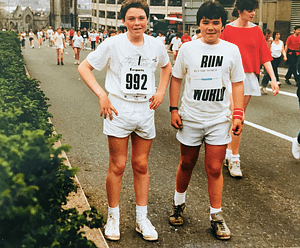How to train for the City to Surf and smash it!
Are you running the City to Surf this year? Here’s how to smash it!
There is more to run training than just going running!
In this article you will learn how to take a comprehensive approach to run training so you can be a better, faster, stronger runner and prevent common injuries. Plus, I share race day tips from the day before to the crossing the finishing line, so you can feel proud of yourself that you smashed it!

From Running the World in 1986 (that’s me on the left!) to a veteran of City to Surfs, half marathons and the full marathon, I’ve done a bit or run training myself, so I have a few good Topp tips for you…
Rookie running mistake
When most people embark on preparing for a run event they typically just go running without much variety, thought or progression. There is so much more to successful run training than just running.
Comprehensive run training involves:
- Start progressively and not over doing it.
- Sufficient warm ups to prepare for each run – especially in the cold winter months – as opposed to walking out the door and starting running almost straight away.
- Stretching afterwards – something so many people skip but it’s so important to manage muscles which are going to take a lot of strain over your run training.
- Strength training to strengthen leg muscles and the core which is the foundation of your legs moving.
- Correct and appropriate run progression in terms of length, time and speeds.
- Adequate rest and recovery to prevent overuse strains and injuries.
Let’s cover these points in more detail….
The right shoes
Before you start all of this, it is worth investing in a decent pair of running shoes. I am sorry but Nike’s are shit! They are fashion shoes not functional running shoes. The best way to tell the integrity of a running shoe is by the base: Does it have a multi-layered base of support or is it just one piece of soft foam (mostly Nikes!)? Personally, I like Asics, I have been wearing and running in them for years!
Run volume, intensity and speed
How much running should you do?
Great question! Like all fitness training it really is prescriptive to the person, fitness level and running level and experience. For this article, we are going to assume a typical moderately active person who does little to some running.
Here is a sequence of run training progression:
- Start with 2-3 runs per week for 20-30-40 minutes at a moderate pace (depending on your fitness) Your first goal is to acclimatise your body to running: it puts a huge strain on the shins, knees, hips and ankles so it’s important to start progressively and not over do it.
Finishing feeling like you could do more is a great sign you are running appropriately.
Feeling like death means you are overdoing it!
- Your goal is to build your time running – not increase the speed, so gradually, as you feel more comfortable, increase how long you run for. Aim for an extra 5-10 minutes per week.
- Once you have built a good running base where you feel comfortable and are not struggling with tight, sore muscles you can start to work on different run intensities. You can add in shorter, faster runs to start to build your running speed and you can also look to slow your pace down to run for much longer, for more of an endurance run.
- Then you can start to integrate running strength by adding in hill sprints, sets of stairs or oval sprints – the idea being you do a short period of intense work and then recover, eg, sprint up stairs and walk down – and repeat. Start with 3-5 sets depending on the length of the hill/stairs and increase the number of sets per week.
Here is a general run plan:
- One standard – your usual pace – run for 30-45mins
- One longer, slower paced run for 50-60 mins (plus)
- One intense run session: fast, short run or interval hill/stair sprints for 20 minutes
- For a fourth run, repeat any one of these options (but you will need time for strength training too so 3 is a good number to aim for)
Warm up and stretching
To avoid overuse strains and injuries you need to warm up thoroughly and spend time stretching afterwards.
Warm up with a walk for 5 minutes and do some running muscle warm ups: hamstring flicks: heel to bum, ankle circles and calf raises.
You don’t need to stretch before the run, you do need to warm up thoroughly.
Stretch afterwards: This is so important for muscle recovery and to prevent overuse injuries like shin splints. You must stretch your running muscles: calves, hamstrings, gluts, quads and a lower back lying twist stretch.

Strength training
A good runner does strength training.
It’s kind of obvious: Strong legs make you a strong runner and it will help prevent injuries.
You don’t need to go to the gym and do weights although that is better. Bodyweight lunging, calf raises and squats will help a lot. One to two sessions per week do three sets of each exercise and build the reps. Start with 10 of each and progress to 20 to 30!
Jedi’s can do stability work such as bosu squats or single leg exercises but this is more advanced and I would prefer to take you through this personally.
Then there is the core…
A strong runner has a strong core.
The core stabilises the trunk and pelvis allowing your legs to do their job well!
Running is essentially a single leg activity, you are transferring your bodyweight from one leg to the next with each stride and your core is the foundation of it all.

Great core exercises include: alternate leg lowers, bicycle crunches, reverse crunches (knees to chest) or even better hanging crunches and a plank. Do 3 sets of each exercise, a couple of times per week, building reps and plank time.
And skipping

Skipping is great for run training because it conditions the calf muscles!
DID YOU KNOW: YOU ARE BORN TO RUN, WE HAVE A SPECIAL LIGAMENT AT THE BACK OF THE HEAD CALLED THE NUCHAL LIGAMENT WHICH STABALISES THE HEAD TO KEEP OUR HEAD AND VISION STEADY (IT IS ONLY PRESENT IN RUNNING ANIMALS)
Recovery
Managing your training schedule should include spreading out your training to allow for suitable recovery time so muscles do not get tired and tight.
Avoid running every day.
Ideally allow for a day or two rest between runs.
You could back up a run session with a strength workout.
If you are really good, you could even dedicate a whole session to stretching and rollering!
The key point is: factor in adequate down time to rest muscles.
You can aid recovery by having salt baths or cold immersion ice baths! (I prefer the salt baths!) after your runs.
It is also recommendable to get a regular massage as your body is going to take a lot of pounding!
Summary
So in review, here is how to be a smart, strong, injury free fast runner:
- Get yourself a decent pair of running shoes.
- Ensure you always warm up sufficiently, don’t go straight into a run.
- Start progressively, don’t do too much too soon.
- Firstly, aim to build running length and time over intensity.
- Next you can introduce faster paces and interval workouts such as hill and stair sprints.
- Aim for 3 runs per week with a variety of running sessions: regular run, slow and long and short and fast / interval session.
- Do one strength session targeting legs and core.
- Ensure you do adequate stretching to help with recovery and prevent overuse injuries and sore muscles.
- Allow for adequate recovery time and recovery activities stretches likes salt/ice baths or massage.
And what about race day preparation?
Here are some race day tips that were featured in TIME OUT magazine:
The day before
(Don’t exercise 2-3 days out)
Have an easy day the day before and drink plenty of water to fully hydrate.
Don’t eat anything unusual, in fact keep foods fairly plain with some extra carbs.
Don’t drink any alcohol!
Get to be on time.
On the morning
Have a glass of water when you wake up but do not drink too much water before the race (you don’t want to be busting before the start – the toilets are busy and not nice!)
Eat your normal breakfast about 2 hours before or something light like toast with jam or peanut butter and /or a piece of fruit like a banana.
Try to go to the toilet before you go!
Get to the start in good time.
Before the race
Start to warm up whilst you stand waiting: jog on the spot and do some run muscle warm up movements: flick your hamstrings (heel to butt), ankle circles, knee to hip raises and some light stretches: calf, quad and hamstring.
On your marks, get set, GO!
Here we go!
Do not make the classic rookie mistake of going too fast too soon! Pace yourself.
It’s going to be very busy, keep your wits about you, be aware of what is going on around you, look ahead and see your way forward.
Avoid zig zagging through the crowd, you’ll waste energy and add unnecessary distance. Try to plot a course for a clear path ahead.
Avoid running on and off curbs – you don’t want to risk twisting an ankle.
You don’t need to stop at all the drink stations, if any, may be one depending how hydrated you feel. Aim for the end of the drink stations where it is less busy and watch out for all the broken, slippery cups on the floor.
After Heartbreak hill
You’ve made it up Heartbreak hill but it’s not all downhill from here! It’s only half way! So keep pacing yourself.
10km
This is where the race really starts, you are probably going to start to get tired and are going to have to work, dig in, you have done the worst of it!
Heading down hill to Bondi beach
You are nearly there, keep soldiering on and dig deep for a strong finish.
The home straight
Time to fly, give it your best sprint for a big finish!
Congratulations you made it!
Time to celebrate and enjoy your achievement!
Don’t forget to do some stretching on those tired legs or they might cease up the next day! Have a hot bath or get a massage and have a beer or three!
And don’t forget to relax and enjoy it!
I see so many people running like they are being tortured! Run with a smile on your face not a grimace!
Try to keep yourself relaxed, especially around the shoulders – don’t hold them up half way to your ears!
GET IN TOUCH: Need help to start running or run a marathon, get in touch so I can personalise a plan for you! Timo Topp is available for proven personal training in Rushcutters Bay park.


